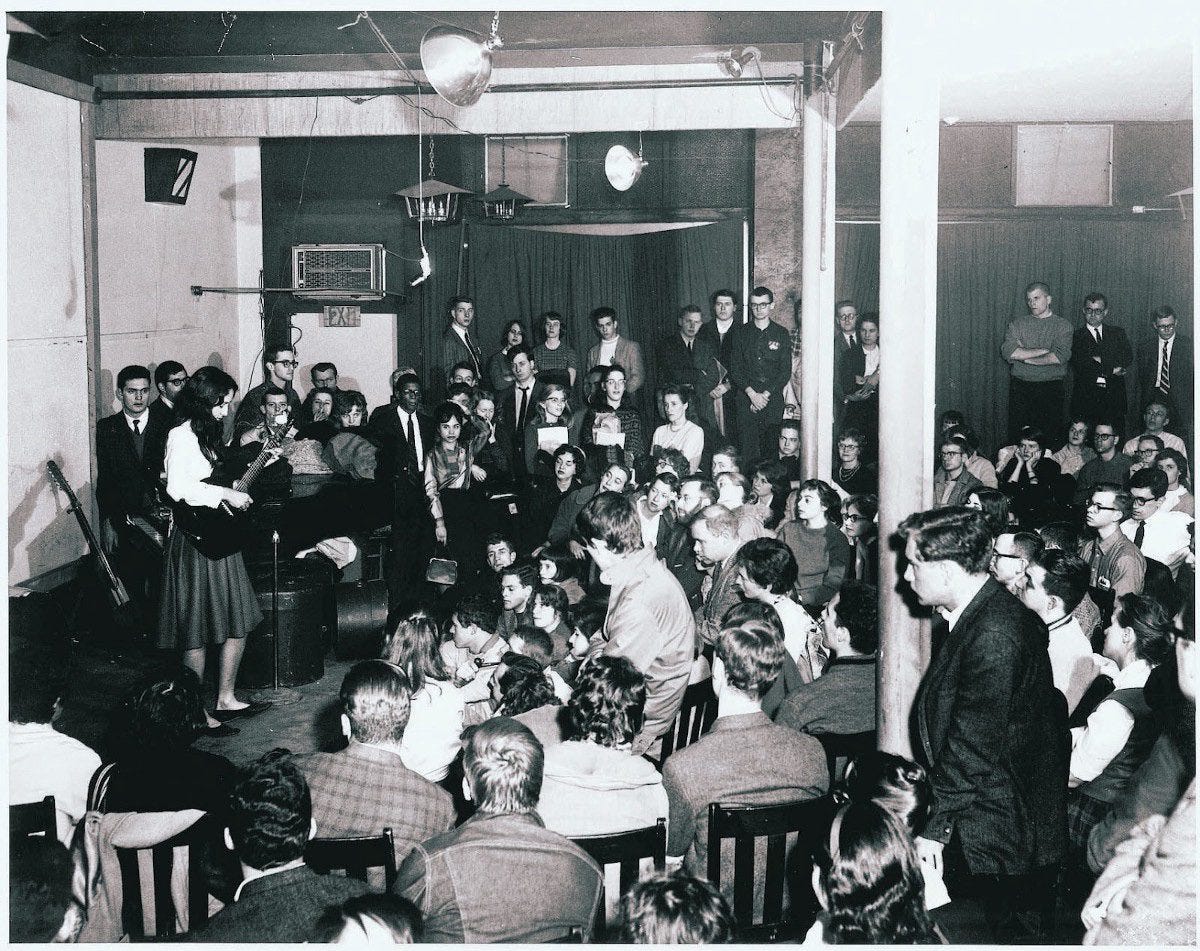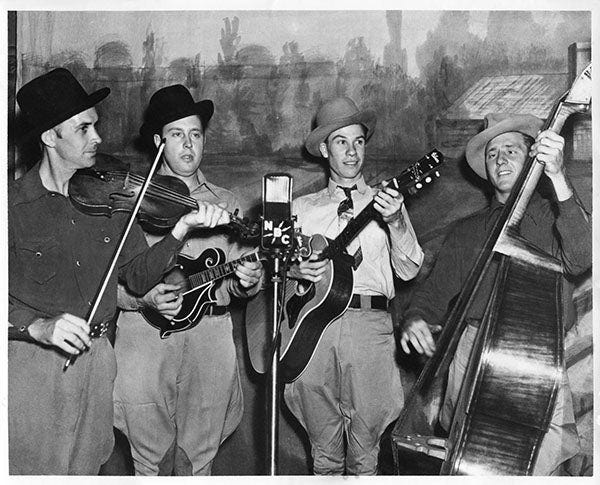Musicking
For the last year or so, I’ve been mixing sound a few nights a month at the famous old folk room in Cambridge MA, Club Passim (originally Club 47). Which means I’m the one who gets the complaint, “more low end in the guitar” from the veteran performer who always strums way up the neck, where there is no low end on an acoustic guitar. I’ve seen remarkable players, and I’m learning from the wide variety of approaches they take to their instruments and voices. But I’ve also seen how sometimes habits formed - especially early in a career - can stick, regardless of their usefulness to the current situation. Drummers don’t always play to the room, in particular; it’s hard for some to adjust dynamics when their stage techniques have been honed under larger, louder circumstances. But it’s not just drummers – a vocalist with a long background in rock clubs might habitually step back from the mic, tighten their throat, and deliver a Springsteen-like shout all evening long, even though we’re in a coffeehouse built for Joan Baez. It can work the other way round, too; some folk players don’t address the microphones or the sound system at all, having come up in truly acoustic rooms. One famous older folk singer I worked with told me to take the mic away from his mouth – “I sing to my audience,” he explained, as I lowered it, and lowered it, and lowered it until he signaled it was perfect down by his Adam’s apple. Bluegrass players – and there are a lot of excellent ones on the folk circuit these days – frequently ask to play into one condenser mic placed center stage, like in black-and-white photos of the Grand Ole Opry. This works fine for those who understand this antique approach to sound reinforcement. But some start wandering all over the place during their show, facing different sides of the room as they solo out of range from any amplification - assuming the mic will follow them as it does when they plug in, which they clearly usually do.
Listening to the space you’re in for music may be natural from the audience side of the stage – but many performers are used to an audio bubble. On a lot of stages, there isn’t a choice – sometimes you can’t hear anything of the sound system that’s necessarily placed between you and the audience, even if you’re in a room not that much bigger than Club Passim. Down the block, in the 500-capacity rock club The Sinclair, I saw Taja Cheek from L’Rain walk to the lip of the stage and try and pivot a PA speaker toward her in the middle of a show. She was trying to hear what the audience was hearing, she explained later. Taja wanted to share the sonic space with her listeners more than the technology in that room permitted. Outdoor shows are the most extreme example of this divide, where there’s no back wall at all for sound to bounce off of – the “inside sound,” as my Japanese friends call a monitor mix on stage, is the only sound the musicians can possibly hear. And it’s a sound only heard by the musicians.
The opposite happens in the coffeehouse, where you can’t make an audio bubble for performers even if you try. A bass player arrived at a recent show with a big amp he placed at the foot of the stage and turned toward himself, to serve as a supplementary monitor to the club’s own. He then took out a pair of in-ear monitors and asked me to send a signal to them, too. This while setting the volume of his instrument too loud for the room (and the rest of the band), without any of it in the sound system at all.
These clashes of habit with circumstance on stage have served as something of a caution for me this year, as I watch my elderly parents struggle with changes in health, as I watch my colleagues in music struggle with changes in the economy, as I watch our entire planet struggle with changes in climate, as I watch myself resisting the many changes in life I didn’t choose or design. Playing to the room might be a goal we could all make better use of. So is sharing the space.
Music as a model for behavior is what led the late music scholar Christopher Small to coin a verb, “musicking,” for the manner in which music is an activity as much or even more than a noun. To Small, music is not an artifact so much as a community. He saw this most clearly in performance:
“When we perform, we bring into existence, for the duration of the performance, a set of relationships, between the sounds and between the participants, that model ideal relationships as we imagine them to be and allow us to learn about them by experiencing them.”
Small identifies both the players and the audience as participants in musicking - and therefore this modeling of relationships through music as “reciprocal.”
“In exploring we learn, from the sounds and from one another, the nature of the relationships; in affirming we teach one another about the relationships; and in celebrating we bring together the teaching and the learning in an act of social solidarity. The simultaneous inward and outward flow of information that goes on throughout the performance is made possible by the fact that the language of the information is not of words but of gestures.”
Listening is a crucial aspect of performance, it is an action as significant to the communicative process Small describes as the music itself. “Gestures,” Small emphasizes, are the basis of information exchange in musicking – and a gesture is not something there is much reason to do on your own, it is a means for communication with others. It’s what musicians share with one another on stage, it’s what we share with the audience, and it’s what the audience shares with the performers. If we all listen.
Are we listening? It’s always possible. And it’s always possible not to, even in a small folk club. Even in a private conversation. Even to yourself.
Listening to: Phasor, by Helado Negro
Cooking: A slice of bergamot in a glass of sparkling water




I can think of a number of parallels, of varying relevance, from the world of jazz. The Modern Jazz Quartet, for one, had remarkable "internal" dynamics. They were always listening to one another's "live" sound on stage. (You never saw any of them complain that they couldn't hear the piano in their monitors.) One of the MJQ players (can't remember which) said that when the band encountered a noisy audience they would keep playing softer and softer until the audience shut up.... Throughout the '70s, in response to rock, acoustic jazz bassist adopted a variety of pickups, plugging directly into the instrument. Wynton Marsalis's record-producing brother Defeayo called this "dreaded direct-to-bass" and avoided it in his recordings. Wynton typically grouped the horn players in his septets around a single mike. Bassist Christian McBride told me that on a gig with Wynton once, he blew out his amp in soundcheck and told Wynton he'd have to find a replacement amp. "Don't use one," Wynton advised. McBride was taken aback, but apparently it worked out fine. I think Marsalis's approach accounts for why so many jazz bassists these days prefer to put a mike near the F hole rather than plug in. I think that approach to acoustic sound was of a piece with Marsalis's stage "gestures," right down the the suits he required all his players to wear.... On a different note, I remember that saxophonist Stan Getz (whose bands had been a progenitor for "jazz-rock"), late in his career would always play one encore number unamplified. "No microphones" he would shout to the soundman, more to make a point with the audience, I think, than with the soundman.
First we are united in Dada invocation, now in "musicking," since almost not a week goes by that I do not cite it as part of the local-music pursuits and community practice. Cheers and kudos!